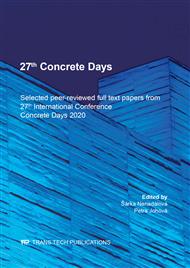p.136
p.142
p.151
p.157
p.163
p.170
p.176
p.185
p.193
Fatigue Behaviour of GFRP Reinforced Beams
Abstract:
This article deals with the influence of fatigue loading on the behaviour of GFRP (Glass Fibre Reinforced Polymers) reinforced concrete elements. The aim of the experimental programme is to quantify the effect of fatigue loading on the mechanical properties of GFRP reinforced beams subjected to flexure. The proposed element was a beam simulating the cut-out part of a reinforced concrete slab directly subjected to traffic loading. The dimensions and the amount of reinforcement were adjusted regarding the possibilities of the testing laboratory and to ensure the repeatability of the test. Two different fatigue loading schemes were experimentally verified: a) a constant load amplitude, b) a gradually increasing amplitude. The applied fatigue load with a constant amplitude was designed to achieve a fatigue life of the element ≥ 2×106 cycles. In the case of fatigue loading with an increasing amplitude, the load was increased every 50,000 cycles by 5% of the maximum load in the cycle. The resulting fatigue life was compared to the expected fatigue life determined according to Miner's rule on linear fatigue summation.
Info:
Periodical:
Pages:
163-169
Citation:
Online since:
August 2021
Authors:
Keywords:
Price:
Сopyright:
© 2021 Trans Tech Publications Ltd. All Rights Reserved
Share:
Citation:


